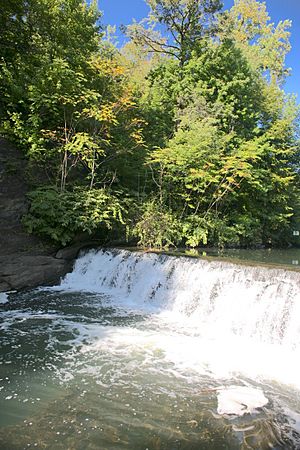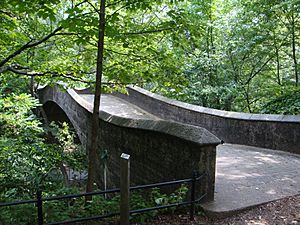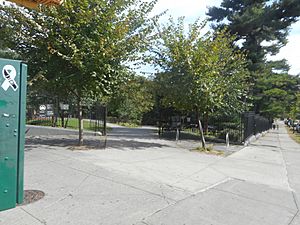Bronx Park facts for kids
Quick facts for kids Bronx Park |
|
|---|---|

South end of Bronx Park
|
|
| Type | Urban park |
| Location | Bronx, New York City |
| Area | 718 acres (291 ha) |
| Operated by | NYC Parks |
| Status | Open |
| Public transit access | Subway: Metro-North Railroad: Harlem Line to Botanical Garden New York City Bus: Bx9, Bx12, Bx19, Bx22, Bx26, Bx39, Bx41 Bee-Line Bus: 60, 61, 62 |
Bronx Park is a large public park located in The Bronx, New York City. It stretches along the Bronx River and is a very important green space for the city. The park is surrounded by different streets like Southern Boulevard, Webster Avenue, Gun Hill Road, Bronx Park East, and East 180th Street.
Bronx Park covers about 718 acres (2.91 km2), making it one of the biggest parks in New York City. It was created in the late 1880s. Today, it is home to two famous attractions: the New York Botanical Garden and the Bronx Zoo. These two places take up most of the park's northern and southern parts. Fordham Road runs through the middle of the park, separating the zoo from the botanical garden. The park is managed by the New York City Department of Parks and Recreation.
History of Bronx Park
How Bronx Park Was Created
Bronx Park was established using money from the New Parks Act of 1884. This law aimed to protect land that would soon become part of New York City. Much of the park's land was bought from Fordham University. The university agreed to sell the land if it was used for a zoo and a botanical garden.
Other parts of the park were bought from the Lorillard family. They owned the Lorillard Snuff Mill, which is now inside the New York Botanical Garden. This old mill is a National Historic Landmark and is the oldest building in the United States used for making tobacco products. Land was also acquired from other important local families, like the Lydigs.
When Did the Park Get Its Main Attractions?
The first 640 acres (2.6 km2) of Bronx Park were bought between 1888 and 1889. In 1891, the northern 250 acres (1.0 km2) were set aside for the New York Botanical Society. Later, in 1897, another 261 acres (106 ha) were given to the New York Zoological Society to create the Bronx Zoo. In 1906, an extra 66 acres (270,000 m2) were added to the park's southeast end. This area is now called Ranaqua and is where the city's Parks headquarters are located.
What Can You Do at Bronx Park?
Most of Bronx Park is taken up by the Bronx Zoo and the New York Botanical Garden. Even though these are private organizations, the New York City Department of Parks and Recreation helps pay for their upkeep. Bronx Park is the third-largest park in the Bronx and the eighth-largest in New York City.
Bronx Park is also a central point for a system of parks across the Bronx. For example, Mosholu Parkway connects to Van Cortlandt Park to the northwest. Pelham Parkway leads to Pelham Bay Park in the east. Southern Boulevard and Crotona Parkway connect to Crotona Park in the south. The park is also surrounded by neighborhoods like Pelham Parkway, West Farms, and Belmont.
The Bronx Zoo and Botanical Garden
New York Botanical Garden
The New York Botanical Garden is in the northern part of Bronx Park, west of the Bronx River Parkway. It was started in 1891 by the New York Botanical Society. The garden covers 250 acres (1.0 km2). Much of this land used to be part of the Lorillard family's property. The garden also includes land that was once part of St. John's College (now Fordham University).
The Botanical Garden has over a million living plants. It also features the LuEsther T. Mertz Library and the Enid A. Haupt Conservatory. Since 1967, the Botanical Garden has been recognized as a National Historic Landmark.
Bronx Zoo
The Bronx Zoo is in the southern part of Bronx Park, also west of the Bronx River Parkway. It was founded by the New York Zoological Society and first opened on November 8, 1899. The zoo is huge, covering about 265 acres (107 ha). This makes it one of the largest city zoos in the United States.
The Bronx Zoo is home to about 4,000 animals from 600 different species. It also has several important historical features. For example, the Rainey Memorial Gates at the Fordham Road entrance are a New York City landmark.
Other Fun Spots in Bronx Park
The eastern side of Bronx Park has many sports facilities. These include fields for baseball, basketball, bocce, football, handball, soccer, and tennis. You can also find hiking trails, places for kayaking, playgrounds, a skate park, and spray showers.
There are seven playgrounds in Bronx Park. Four of them are along Bronx Park East or Bronx River Parkway. These are Ben Abrams Playground, Brady Playground, Waring Playground, and Rosewood Playground. The park also has three bike paths. The longest one runs north-south along Bronx River Parkway. Other paths go northwest along Mosholu Parkway and east along Pelham Parkway.
Nature and Playgrounds
The northern part of Bronx Park is a special "Forever Wild" nature preserve. This 35 acres (14 ha) area is protected from development. It has a unique forest with eastern hemlock trees and hardwoods. Several walking trails run through this forest. It is believed to be the only woodland in New York City that has never been cleared.
Near the preserve are the Allerton Avenue Ballfields. These fields are named after Daniel Allerton, an early settler of the Bronx. They have three baseball fields and a comfort station. The Bronx Skate Park is also nearby, on Bronx Park East. Two more playgrounds, French Charley Playground and Frisch Field, are next to the northern part of Bronx Park.
Ranaqua and River Park
The southeast part of the park, called Ranaqua, is the Bronx headquarters for NYC Parks. The name "Ranaqua" comes from an Algonquin word meaning "End Place." This was the original name of the land sold to Jonas Bronck, who the Bronx is named after. The brick buildings at Ranaqua were built in the 1930s as part of a government project.
The southwest corner of Bronx Park has River Park. This small park and playground overlooks the Bronx River, just south of the zoo. It is located near the 182nd Street Dam, which is a small waterfall on the river.
Water in Bronx Park
The Bronx River
The main waterway in Bronx Park is the Bronx River. It flows south from Westchester County to the East River. About 2 miles (3.2 km) of the river runs through the park. This part of the river is mostly natural. It has a rich ecosystem with a swamp and forest of red maple trees. Several smaller streams flow into the river from the New York Botanical Garden and the Bronx Zoo.
The Bronx River used to be very polluted. But thanks to efforts by the Bronx River Alliance, it was cleaned up in the late 20th century. The Mitsubishi Riverwalk, a public trail along the river, opened in 2004. It runs along the eastern bank of the river within the Bronx Zoo's parking lot.
Waterfalls in the Park
There are three waterfalls in Bronx Park. One is a cascade near the Lorillard Snuff Mill. Further south, there's a pink granite waterfall about 12 feet (3.7 m) high. It's just upstream from the zoo's Boston Road entrance. Here, a small island splits the waterfall into two parts.
A third waterfall is the 182nd Street Dam near River Park. This dam was once used by the DeLancey family, who had a farm where the Bronx Zoo's Wild Asia section is now. Today, it's a dam with a fish ladder to help fish move upstream. This waterfall was also known as Delancey's Falls or Lydig's Falls.
Lakes in Bronx Park
Bronx Park has two main lakes along the Bronx River. South of Fordham Road, the river widens into a small lake called Lake Agassiz. This lake is fed by two streams from inside the zoo. In the early 1900s, it was about 6 acres (2.4 ha). However, in 1971, about 3 acres (1.2 ha) of Lake Agassiz was filled in to create a new bison "prairie" at the Bronx Zoo.
A larger lake, the 25-acre (10 ha) Bronx Lake, is south of Lake Agassiz. It stretches for almost 1 mile (1.6 km) through the zoo. People used to go boating on Bronx Lake. In 1911, over 46,000 people enjoyed boat rides there. The lake used to have a boathouse north of the 182nd Street Dam, but it was taken down after the 1950s. The Bronx Zoo's JungleWorld exhibit was built on the boathouse site in 1983.
Other Ponds
There are also other ponds in Bronx Park that are not connected to the river. Cope Lake, near the Fordham Road entrance to the Bronx Zoo, existed before the zoo was built. In the mid-1900s, it was home to pelicans. However, the pelicans were moved to an indoor exhibit in the 1990s. In 2009, the Center for Global Conservation opened on the lake.
Another pond, Twin Lake, is in the northern part of Bronx Park, next to the Pfizer Lab in the New York Botanical Garden. This pond used to be a public area but is now part of the botanical garden.
Images for kids





